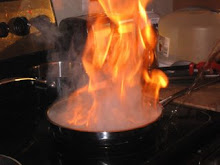Veal stock is another. Completely. And totally. Another. So settle in for the story of a stock that takes 12 times as long as chicken stock. (For you 1st graders out there, that's 24 hours.)
I started with 16 pounds of veal bones from Eastern Market. It's the closest thing I can find in DC to this place back in home sweet home ATL. It's not quite the same, but it makes a good effort. I let a roasting pan get realllly nice and hot in a 450 degree oven until I tossed the first of the bones in and I got that satisfying sizzle that tells me they're going to be cooked from both sides. They roasted for 45 minutes before I took them out and tossed them into my ginormous stock pot. After covering in cold water, I verrrrry slowly brought them up to a simmer at about 190 degrees (aided by my sexy new IKEA meat thermometer. Yes I called a thermometer sexy, and yes I have problems. Hush.). The time was 10:30pm.
After about three hours of simmering and skimming, I strained the first liquid into a second stock pot, added more water to the bones, and brought back up to a simmer. This second soaking of the bones is called a remouillage and is designed to extract maximum flavor from the bones. During the initial soaking of the bones, the water and the bones reach an equilibrium in flavor. To get more flavor, you need to add new, unflavored water. The remouillage drains more flavor from the bones and then gets added back to the original liquid and reduced later.
So after adding cold water, I brought the stock back up to a simmer and then stuck it in a 190 degree oven overnight. The first liquid sat, reducing, on a burner on low overnight as well. At this point it was past 2am.
I woke up in the morning around 10am to an apartment filled with the most warm, intoxicating fragrance I can imagine. Well, except for cookies. Cookies smell better, but not by a whole lot. And brownies. Ok, excluding baked goods...this smelled better than most anything I can imagine.
Finally, I discarded the bones. At this point, the stocks were still too large to fit in one pot (or, to be honest, two...I had three burners going for most of the morning). I added two cans of tomato paste and let the stock continue to reduce. Reduce and skim. Skim and reduce. Hours and hours of it. At about 3pm I added a mirepoix, along with some fresh thyme, garlic, and bay leaf. I let these cook (while skimming) for about two hours before straining them out. It was 5:30 by the time I got the stock back up to a simmer, but hark! It finally all fit in a regular sized stockpot--not even just the humongo one I had been using earlier.
I left for a few hours, came back, and finally found it had the body that I wanted it to have. It was 10pm. I strained the final product through a double rinsed-cheesecloth and my chinois and only then did I really see the beautiful dark brown stock, free of impurities and bursting with this amazing strong and yet somehow neutral flavor.

All it needed was a sprinkling of salt before I stored and froze it.
Why go through all this? Veal stock is the foundation of the basic brown sauce, of which there are at least dozens of derivatives: espagnole (one of the mother sauces of classical french cuisine), bordelaise, demi-glace....you name it. If it's a brown sauce, it is (or should be) based on a veal stock.
And with two upcoming dinners of epic proportions, it definitely made sense to have some on hand. More on these later...

0 comments
Post a Comment